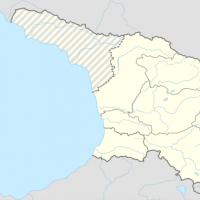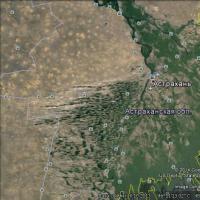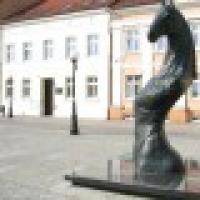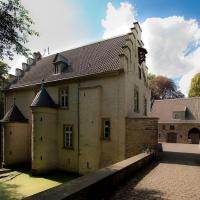Accommodation options in the city of Hagen. Hagen, Germany: why go, what to do, where to eat, travel tips Where and what to eat and drink in Hagen
listen)) is a city in western Germany, in the federal state of North Rhine-Westphalia.
The population is about 200 thousand people.
The main attractions of the city:
Hagen railway station (German hagen Hauptbahnhof listen)) is the city's main railway station. The building is located on Berlinerplatz. Both the station and the glazed canopies over the platforms have retained their appearance almost unchanged since the beginning of the 20th century.
Werdringen Castle (German Wasserschloss Werdringen) - a complex of castle buildings surrounded by water. The castle is located 500 meters from the shore of the Harkortsee reservoir, surrounded by centuries-old trees on the territory of a reserve that protects rare species of amphibians and dragonflies.
Not far from the castle is the former quarry Siegeleigrube Vorhalle. It contained the remains of the oldest flying insects on the planet, which lived in the Carboniferous period 318 million years ago.
Not far from the castle at the foot of the Kaisberg mountain, three Bronze Age swords were discovered in 1876 - this is the oldest archaeological find in the Ruhr area. All finds are presented in the museum of this castle. Detailed information about the finds can be found on the museum website: http://www.historisches-centrum.de

Tower of Baron vom Stein (German Freiherr- vom- Stein- Turm) is a memorial tower. It is located in the Vorhalle district on the top of the Kaisberg mountain at an altitude of 185 m above sea level.

Hagen Correspondence University!
The only public distance learning university in Germany. If you are unable to study full-time, but really want to get a European diploma, then this university is for you. This educational institution is focused on the use of the latest teaching and communication technologies.

This German university was founded in 1974. About 90 thousand students study at the university.
The university has 4 faculties:
- Faculty of Humanities and Social Sciences
- Faculty of Mathematics and Informatics
- Faculty of Economic Sciences
- Faculty of Law
Opportunity to get:
- Bachelor's degree- training lasts 6 semesters. The first four semesters students study the main subjects. The next step is an exam, in case of successful passing, they proceed to an in-depth study. At the end of the course, a final exam is taken and a bachelor's degree is awarded.
- Master's degree - training lasts 4 semesters.
- Postgraduate Diploma- individual training programs for 6 semesters.
Education at this university in Germany is done in German.
Basic learning format- remote, but it is possible to study full-time. The main campus of the university is located in the German city of Hagen. Students of this German university can choose a blended form of study, which includes both distance courses and face-to-face classes.
University of Hagen cooperates with the Technical University of Karlruhe, the University of Jena and the University of. Johannes Kepler in Linz.

Entry conditions:
The main requirement for admission to this German university is a good command of the German language. Foreign applicants must confirm their knowledge with an appropriate certificate.
For admission to individual programs, additional requirements are possible, but usually they relate to the level of education received.
Payment is made for each course of study, depending on the estimated teaching hours of each semester. The corresponding fees depend on the status of the "listener".
Outstanding Alumni: Selma Ergech, Oliver Kahn, Andrea Petkovic, Marissa Nashushen.
University website:
vkontakte group:
This article is about a small town in northwestern Germany, Hagen. Today, Hagen has a little less than 200 thousand inhabitants.
Geographic location of Hagen.
Hagen is a city in Germany, which is located in the west of the country, part of the Ruhr region (German: Ruhrgebiet), and is located almost in the center of the federal state of North Rhine-Westphalia (German: Nordrhein-Westfalen).
The federal state of North Rhine-Westphalia borders on the Netherlands, Belgium, on the lands of Lower Saxony (German: Niedersachsen), Hesse (German: Hessen), Rhineland-Palatinate (German: Rheinland-Pfalz).
And the very center of North Rhine-Westphalia is the Ruhr region. The largest cities in the region are Bottrop (German Bottrop), Gelsenkrichen (German Gelsenkirchen), Herne (German Herne), Recklinghausen (German Recklinghausen), Dortmund (German Dortmund), Hamm (German Hamm), Bochum (German . Bochum), Essen (German Essen), Oberhausen (German Oberhausen), Mulheim (German Mülheim an der Ruhr), Duisburg (German Duisburg), Moers (German Moers).
Most of the land area of North Rhine-Westphalia is occupied by meadows, fields, forests. North Rhine-Westphalia is rich in protected areas - there are more than 14 reserves.

The climate of Hagen.
Due to the fact that North Rhine-Westphalia is rich in water resources, rivers such as the Rhine (German Rhein), Ems (German Ems), Ruhr (German) Ruhr, Weser (German Weser) flow through the earth , Lipe (German Lippe), Pader (German Pader) - then the climate in the region, and accordingly in Hagen, is mild, temperate continental. The average annual temperature of the earth ranges from 5 to 10°C. The average temperature in January is +1 - +4°С, and in July +13 - +22°С.
History of Hagen.
The first mention of Hagen, or rather of the castle built on its land, dates back to about 1200. The name of the city comes from the name of a farm that was previously located on the site of the future city.
But today's territory of Hagen was inhabited in the prehistoric era. Stone tools, fragments of pottery and other valuable archaeological finds were found on the territory of the city and the surrounding lands, which confirm that the territory of Hagen was inhabited about 40 thousand years ago, i.e. people lived here during the Middle Paleolithic.
In the Neolithic era, the first human settlements appeared on the territory of Hagen. From the era of the Bronze and Iron Ages, several burials of that time have survived to the present day.
And in the Stone Age to the present day, people lived in the Blatterhole Cave (German: Blätterhöhle). It was there that the remains of people were found, which today are about 10 thousand 700 years old. Other remains found in the same cave are 5,600 years old. Blätterhöhle cave is one of the unique caves in Europe.
The era of the early Middle Ages and the history of Hagen of that time are practically not studied, since not a single record, not a single historical monument of those times has survived to this day. The only thing known today is that in the 12th century Hagen belonged to the Cologne.
In 1324, the County of von der Mark (German: von der Mark) became the owners of the town and Vollmarstein Castle (German: Burg Volmarstein).
The relative historical calm in the Middle Ages on the territory of Hagen is primarily due to the fact that the town was not of strategic importance compared to the Brandenburg cities in the vicinity, but compared to the neighboring town, the castle, which belonged to the county of Limburg (German: Limburg).
In the 17th century, Hagen survived the Thirty Years' War and the plague, like many other cities in Germany and Europe at that time.
And at the end of the 17th century, the economic, political and social growth of the city began, and all thanks to the fact that the Klingenschmiede forge was opened here. The streets of the city are growing, the population of the city is growing. But in 1699, almost everything in the city was destroyed by fire, and there was a strong fire in 1724. And only in the 30s of the 18th century Hagen began to recover - the economic and social development of the city took place, which, unfortunately, was suspended with the course of the Seven Years' War in 1756-1762.
At the beginning of the 19th century, Hagen finally became a Prussian city. And at the end of the 19th, beginning of the 20th century, there were already more than one hundred thousand inhabitants in Hagen, Hagen turned into a large industrial center, which it remains to this day.

Sights of Hagen.
First of all, in Hagen it is worth visiting the Emil Schumacher Museum, dedicated to the life and work of the great artist. The museum has a large collection of the author's works - oil paintings, gouache, graphics, ceramics by the famous post-war expressionist Emil Schumacher. Here, in the house-museum, you can see other art exhibitions of contemporary art.
Osthaus Museum (German: Osthaus Museum) Hagen. The Osthaus Museum was built in a modernist style by the Belgian architect Henry van de Velde. The museum constantly hosts exhibitions of modern art, classics of German art, in particular, the museum has an exhibition of German expressionism.
The Osthaus Museum houses over a thousand works of art, over 800 sculptures, and over 250 art objects.
It is worth visiting in Hagen and the Westphalian Museum of Agriculture, Technology and Professions (German: Westfälisches Landesmuseum für Handwerk und Technik). Here, guests of the city will be able to see the production with their own eyes - on the territory of the museum there are more than 60 workshops that are open to the public, there are factory production, handicraft production - from provincial crafts to modern crafts. Guests will be able to see machines, equipment, old machines, as well as guests can make a rope or make a sheet of paper, treat themselves to beer from a local brewery, and visit the forge.
In the Historic Center of Hagen (German: LWL Freilichtmuseum), guests will be able to visit a real time machine that will take visitors through the centuries to the prehistoric period - to the first human settlements in the city. In the Historic Center of Hagen there are permanent thematic photo exhibitions, art exhibitions, video animations, visitors can watch modern videos about the history of the city.
Museum of Early History and Primitive Society (German: Museum für Ur- und Frühgeschichte). The museum is located in a real castle, which is surrounded by a moat filled with water - in Werdringen Castle (German: Werdringen). The museum has exhibits that represent the whole long history of Hagen. The youngest visitors to the castle will enjoy copies of dinosaurs, animals of the Ice Age, various tools of primitive man, and the remains of people from the Stone Age.
Hohenlimburg Castle (German: Hohenlimburg). This castle is the only castle in Westphalia that has survived to this day. The castle wall, which was built in 1242, is still preserved. It is about this castle that there are first documentary references of the 13th century. To date, the castle has an exhibition dedicated to the life and life of the princes of the 18-19th century.
Hoeenhof or High Courtyard (German: Hohenhof). In 1908, the philanthropist Karl Ernst Osthaus lived in Hohenhof. In Holenhof, the works of such masters as Henry van de Velde (German Henry van de Velde), who was the architect of the building and designer of the interior decoration of the building, Ferdinand Hodler (German Ferdinand Hodler) and Henry Matisse (German Henry Matisse) are collected.

Excursions from Hagen.
In Dortmund, neighboring Hagen, you can see the city's Old Market; the church of St. Rinald (German: Reinoldikirche), made in the Romanesque style and built, presumably, back in the 9th century; the Eagle Tower (German Adlerturm), which was built in 1992 on its historical foundation, the six floors of the tower now house the Dortmund Museum, which exhibits the archaeological finds of the city; it is worth seeing the church of St. Ewald and the old town hall, the church of St. Peter (German: Petrikirche) and the Pastor's Church (German: Propsteikirche), the Church of St. Mary (German: Marienkirche), the Church of John the Baptist (German: Propsteikirche St. Johannes Baptist), the Church of Boniface (German St. Bonifatius Kirche), and numerous museums of the city.
In Bochum, also a city in the Ruhr region, you can see the Church of the Holy Apostles Peter and Paul (German: St. Peter und Paul) - one of the oldest churches in Westphalia; the Cistercian Monastery (German: Zisterzienserkloster Stiepel), which was founded in 1988; the Bochum bell, which was installed at the city hall and took part in the World Exhibition in Paris in 1867; Bochum Geological Park (German: Geologischer Garten), in which you can see geological deposits of different periods of the life of the earth, starting from the Carboniferous period (358 - 296 million years.
In Oberhausen, you can visit the Oberhausen Castle (German: Schloss Oberhausen), made in the classical style, founded in the late 12th and early 13th centuries; castle Burg Fondern (German: Burg Vondern), founded presumably in the 12th century; Holten Castle (German: Kastell Holten), founded in the 14th century, but the first mention of it dates back to the 12th century; gasometer (German: Gasometer Oberhausen), which is now a monument of industrial architecture; Gantil waste heap (German: Halde Haniel) - one of the highest waste heaps, on the plateau of which cultural events are often held; Osterfeld (German: Zeche Osterfeld) and Shterkrade (German: Zeche Sterkrade) mines - both inactive; It is also worth visiting the various museums of Oberhausen, the model railway of the Ruhr region (German: Die Modellbahnwelt Oberhausen) and the Sea Life Aquarium, where until recently the famous octopus Paul lived.
Places for entertainment and shopping in Hagen.
Hagen has more than 1300 shops and shops that can satisfy the tastes of even the most demanding customers. The center of shopping is the territory of Elberfelder Street (German: Elberfelder Straße) and the Folme Gallery (German: Volme Galerie).
Also in Hagen it is worth visiting the outdoor and indoor pools.
In addition, Hagen has a large selection of hotels for every taste and different price categories.
Restaurants in the city surprise with their variety of menus and gastronomic delights.
Visitors to the city should definitely visit the annual fairs, relax in the parks of Hagen, ski in the Sauerland (German: Sauerland) or enjoy surfing on one of the many artificial reservoirs in the Ruhr region.
Hagen is one of the largest cities in Germany (39th place), a quiet, calm, green town located in the center of the Ruhr region. The city is rich in beautiful natural views, museums, archaeological finds. In addition, the city has a university (German: FernUniversität Hagen) - the only state-funded distance learning university. Naturally, FernUniversität is the largest university in Germany.
The town of Hagen is located in North Rhine-Westphalia and occupies almost the entire southeastern part of the Ruhr region. In relative proximity to it is the city of Dortmund. Hagen has developed paper, textile and metallurgical industries. The city is also called the gate of the Sauerland, as it has a border with its northwestern part. Hagen has a lot of vegetation and trees, which is why it is also called the "Green City". Several rivers run through its territory, and there are two reservoirs.
View from Castle Weather in Hagen, Germany (Photo © Frank Vincentz / commons.wikimedia.org / Licensed CC-BY-SA-3.0)
What to see in Hagen?
Freilichtmuseum. You can get to this city of masters by bus. Here is a small village, which presents various types of manual labor - from a home bakery and a smithy to the manufacture of ropes and cigars. Visitors can also take part in the manufacture of some things - print a postcard or forge a nail. Hagen, Mackingerbach.
Hohenlimburg Castle (Schloss Hohenlimburg). It is worth visiting for those who are fond of history and architecture. From the outside, the castle looks small, but from the inside, it seems much larger. It is better to get to it by private car. Hagen, Alter Schlossweg 30.
Water castle Werdringen. It is located near the city of Hagen and outwardly not as attractive as other German castles. It is surrounded on all sides by a large, deep moat with blooming water. You can also visit the museum, which displays exhibits found in the Ruhr area. Nearby is a large reservoir with yachts and a forest. Hagen, Werdringen 1.
Osthaus Museum Hagen. Currently, the works of the artist Hundertwasser are exhibited in its building. There is also an architectural exposition, where models of buildings are presented to the public. Hagen, Museumsplatz 3.
Emperor Friedrich Tower (Kaiser Friedrich Turm). Climbing this attraction you can enjoy the most beautiful panoramic view of Hagen. Next to the tower is a restaurant and a beer garden.
Bunker Hagen. Here tourists can experience the same feelings as people during the war. Inspection of this attraction takes place with the help of a flashlight, as there is no lighting. All available exhibits can be touched. Hagen, Bergstr. 98.
Johanniskirche. This church stands in the center of Hagen and is one of its attractions. Inside her building there are no special decorations, but here you can feel a special spirituality. Hagen, Frankfurter Strasse.
 Architecture in Hagen, Germany (Photo © Frank Vincentz / commons.wikimedia.org / Licensed CC-BY-SA-3.0)
Architecture in Hagen, Germany (Photo © Frank Vincentz / commons.wikimedia.org / Licensed CC-BY-SA-3.0) What to do in Hagen?
Go to a performance at the Theater Hagen, which is famous for its unique productions.
Admire the beauty of the government building - the city hall Rathaus Hagen, which was built in a typical German style.
Go to the Emil Schumacher Museum who has prepared real masterpieces in different fields.
Take a look at the Volkssternwarte Hagen Planetarium, which is famous for its interesting productions, and there is also an observatory here.
Relax in the Westfalenbad Spa, where you can improve your health and relax after a busy sightseeing.
Go for a walk in Hamecke Park where a calm and peaceful atmosphere reigns, combined with the beauty of the surrounding nature.
Get to know German and world cinema, having visited the cinema Kulturzentrum Pelmke, where world premieres are regularly shown.
See UniversityFernuniversitytHagenFernuniversitathagen, it is notable not only for its architecture, but also for being the largest university in Germany in terms of the number of students.
Go to the specialty museum Hohenhof, the house itself, where the unique exposition is located, is also interesting, it is definitely worth a walk.
 View from the Goldberg in Hagen, Hagen's new Sparkasse building, Rathaus, Germany (Photo © Frank Vincentz / commons.wikimedia.org / Licensed CC-BY-SA-3.0)
View from the Goldberg in Hagen, Hagen's new Sparkasse building, Rathaus, Germany (Photo © Frank Vincentz / commons.wikimedia.org / Licensed CC-BY-SA-3.0) Where and what to eat and drink in Hagen?
Novy's Restaurant. In this restaurant, you can try a wide variety of food, in addition to which a wine list and a variety of mineral waters are available to visitors. Average check: 11 euros.
Restaurant Gyrosland Hagen. Here visitors will be offered dishes of German and Greek cuisine. The staff of the institution speaks different languages. Average check: 8 euros.
SteakhouseHohoff 800°TheGoldenCage. Meat lovers should definitely visit this place. Here you can try steaks of different roasts with various sauces, and they are served with beer and wine. Average check: 14 euros.
The easiest way to get acquainted with the local color and make new acquaintances is in bars and clubs; Kanapee, Grammophon, Grammophon are in special demand.
German delicacies and interesting souvenirs can be purchased at the Volmegalerie Hagen store, where fairly affordable prices are set.
View of the town hall of Hagen, Germany (Photo from above© Hans Peter Schaefer / commons.wikimedia.org / License CC-BY-SA-3.0-migrated)
How do we save up to 25% on hotels?
Everything is very simple - we use a special RoomGuru search engine for 70 hotel and apartment booking services with the best price.Bonus for renting apartments 2100 rubles
Instead of hotels, you can book an apartment (1.5-2 times cheaper on average) on AirBnB.com, a very convenient worldwide and well-known apartment rental service with a bonus of 2100 rubles upon registration
Hagen is another city that does not have anything interesting on its territory, for which it would be worth a look. And this is not some tiny village - the population of Hagen is almost 200,000 people, so the city for Germany is very, very large. And it is located, which is not surprising, in the Ruhr region (where else is there an absolutely nondescript, but large settlement). But I will try to "pull by the ears" one fact that distinguishes Hagen from other cities.
Germany has a huge number of higher education institutions; Almost every major city has a university, or even several, on its territory. The vast majority of them are state-owned (there are very few private universities in Germany). Some universities are known all over the world, and some may not even be known in a neighboring city. In general, nothing unusual. A distinctive feature of the German higher education system is that local universities practically do not offer distance education programs. At the same time, “practically” means that for several dozen universities there will be good if there is one correspondence program, or even none at all.
But what about people who are already working, but want to either retrain or get a higher academic degree? You can, of course, drop everything and go to study on a full-time program, but not everyone is ready to live on a student subsistence level. You can also enroll in one of the few private universities - they just often offer correspondence courses, but then where is the vaunted German free education?
Actually, there is a way out. And this exit is the Hagen Correspondence University (Fernuniversität in Hagen). It was here in 1974 that higher distance education programs were collected from all over Germany, drawing the line between German full-time and distance learning. As you can see, the university has been successfully functioning to this day, being the largest university in Germany in terms of the number of students (74,205 people).
By the way, not only residents of Germany, but also any other countries can study at the Hagen Correspondence University: you just need to present the appropriate school diploma, a certificate of German language proficiency and other necessary documents, and while studying, take exams in special accredited centers. So without leaving, for example, Russia, you can learn and get a real diploma from one of the universities in Germany.
And now the university itself. Despite the fact that it is part-time, the Hagen campus was rebuilt hoo. 

So if someone in Germany knows something about Hagen, it is solely thanks to this university. 
Because there is nothing else remarkable in the city. Even the center, where locals come for a walk (it’s hard for me to imagine that they are visitors), looks as faceless as possible. 


The only thing I liked about Hagen was the stream fountains below the road level. I love it when a small stream strives somewhere among the stone. 
In the center there are several buildings built at the beginning of the last century, but they do not stand out from the general picture and look completely nondescript. 
This gray and incomprehensible monument to me is very indicative of Hagen. Usually, when I travel, I never take pictures of such nonsense and, moreover, I don’t post it on my blog, but here I needed to take at least a couple of dozen pictures corny. And there was nothing else to shoot. 
I was in Hagen in 2016, when the whole world mourned the events in France. 
In Hagen, of course, there is also a small semi-pedestrian quarter, but it looks like a city. If you compare Hagen with the post-Soviet countries, then imagine the city center, consisting entirely of gray brick Khrushchev. For Germany, this is a similar view. 


The only decent-looking building that caught my eye is the local theater. 
Thus, Hagen turned out to be one of the most boring cities in Germany. It is better even to go 5 times to a completely uninteresting Dortmund than to visit Hagen once.
By clicking anywhere on our site or clicking "Accept", you agree to the use of cookies and other personal data processing technologies. You can change your privacy settings. Cookies are used by us and our trusted partners to analyze, improve and personalize your user experience on the site. In addition, these cookies are used for targeted advertising that you see both on our site and on other platforms.Hagen: Contents 1 Places 2 People 3 Other 4 See also ... Wikipedia
Hagen im Bremischen- The municipality of Hagen im Bremischen Hagen im Bremischen Coat of arms ... Wikipedia
HAGEN (Hagen)- a city in Germany, the land of North. Rhine Westphalia. 214 thousand inhabitants (1991). Mechanical engineering, metallurgy, metalworking… Big Encyclopedic Dictionary
Hagen- This term has other meanings, see Hagen (meanings). City of Hagen Hagen Coat of arms ... Wikipedia
Hagen, Herman August— Hermann August Hagen Hermann August Hagen ... Wikipedia
Hagen- (Hagen), a city in Germany, North Rhine Westphalia. 214 thousand inhabitants (1995). Mechanical engineering, metallurgy, metalworking; textile, paper, furniture industry. * * * HAGEN HAGEN (Hagen), a city in Germany, the land of North Rhine ... ... encyclopedic Dictionary
Hagen, Herman
Hagen G.- Hermann August Hagen (1817 1893) Hermann August Hagen (German: Hermann August Hagen, May 30, 1817, Königsberg November 9, 1893, Cambridge, Massachusetts), an outstanding German entomologist. In 1836, he entered the medical faculty of the Königsberg as a student ... ... Wikipedia
Hagen Hermann August- Hermann August Hagen (1817 1893) Hermann August Hagen (German: Hermann August Hagen, May 30, 1817, Königsberg November 9, 1893, Cambridge, Massachusetts), an outstanding German entomologist. In 1836, he entered the medical faculty of the Königsberg as a student ... ... Wikipedia
Hagen G. A.- Hermann August Hagen (1817 1893) Hermann August Hagen (German: Hermann August Hagen, May 30, 1817, Königsberg November 9, 1893, Cambridge, Massachusetts), an outstanding German entomologist. In 1836, he entered the medical faculty of the Königsberg as a student ... ... Wikipedia
Books
- Ideal plants for your garden, Thomas Hagen, Ursel Borstel. Are you looking for the most beautiful plants for shady areas? Or flower beds in your favorite shade? Do you want to arrange a flower garden in a strict classic, ordinary rural or bright ... Buy for 410 rubles
- We are planning a garden. Lighting in the garden. Training. Planning. Calculations, Peter Hagen. Do you want to transform your site or its individual corners or just not to stumble in the garden after dark? This book will tell about both the decorative and the practical side ...
 Consider each of the requirements for metal detectors
Consider each of the requirements for metal detectors Metal detector in an educational institution
Metal detector in an educational institution How to wipe the TV screen at home
How to wipe the TV screen at home Senaki mikha tskhakaya. Mikha tskhakaya. Notable residents of the city
Senaki mikha tskhakaya. Mikha tskhakaya. Notable residents of the city International Journal of Applied and Basic Research Volgo-Caspian Shipping Canal Main Bank
International Journal of Applied and Basic Research Volgo-Caspian Shipping Canal Main Bank How to deal with sunburn if you are burned
How to deal with sunburn if you are burned Hagen, Germany: why go, what to do, where to eat, travel tips Where and what to eat and drink in Hagen
Hagen, Germany: why go, what to do, where to eat, travel tips Where and what to eat and drink in Hagen